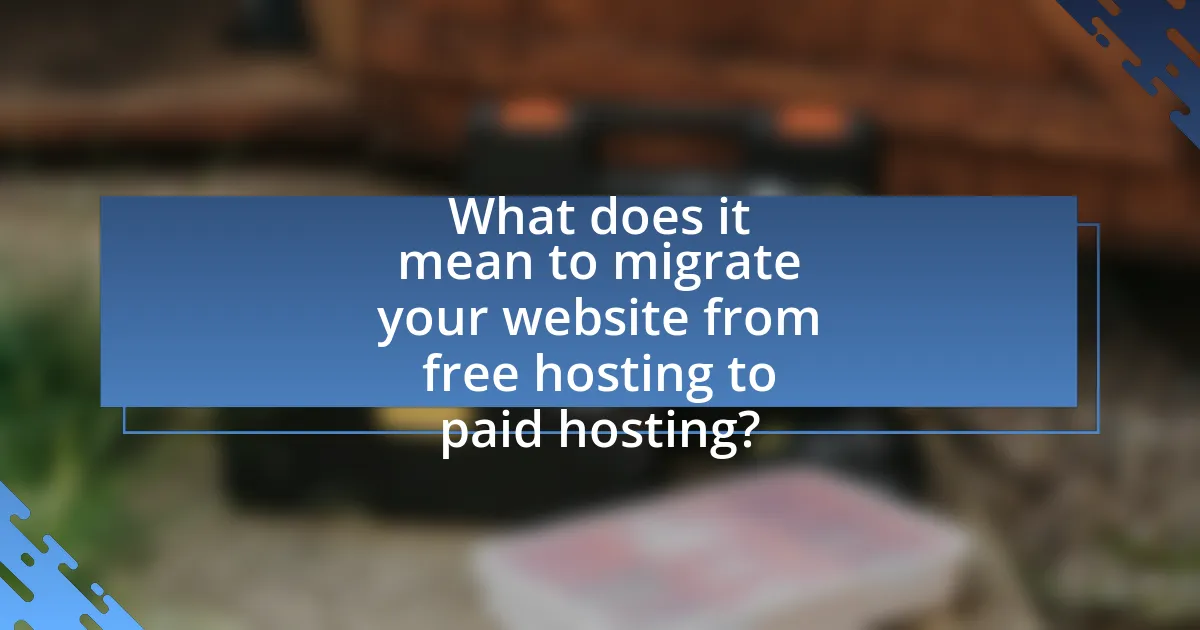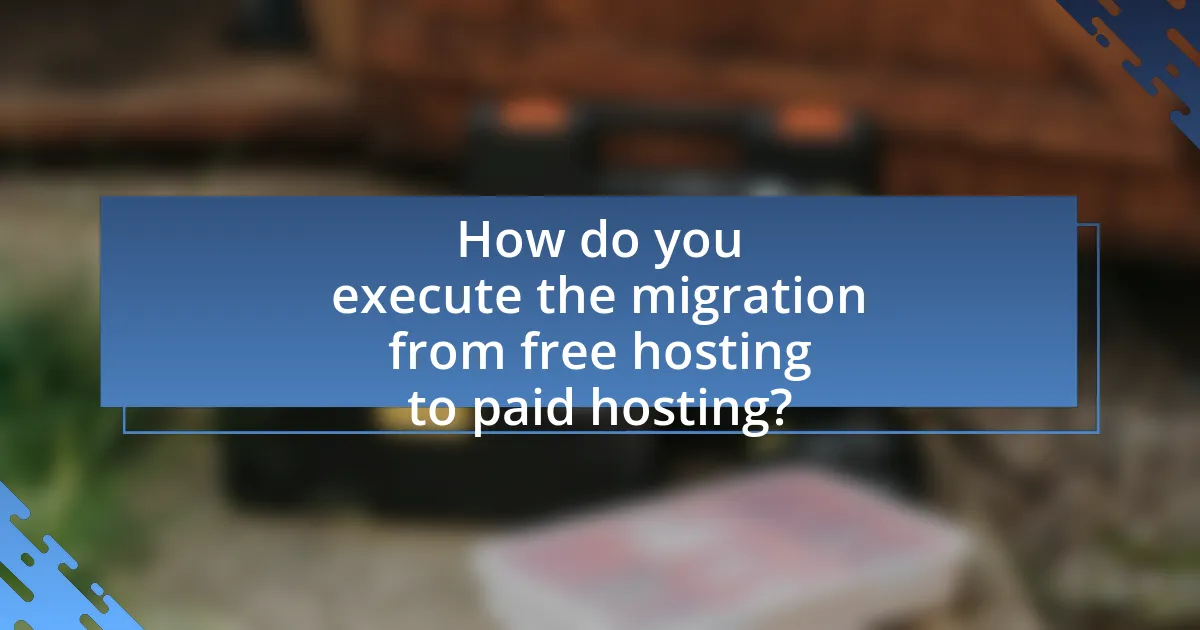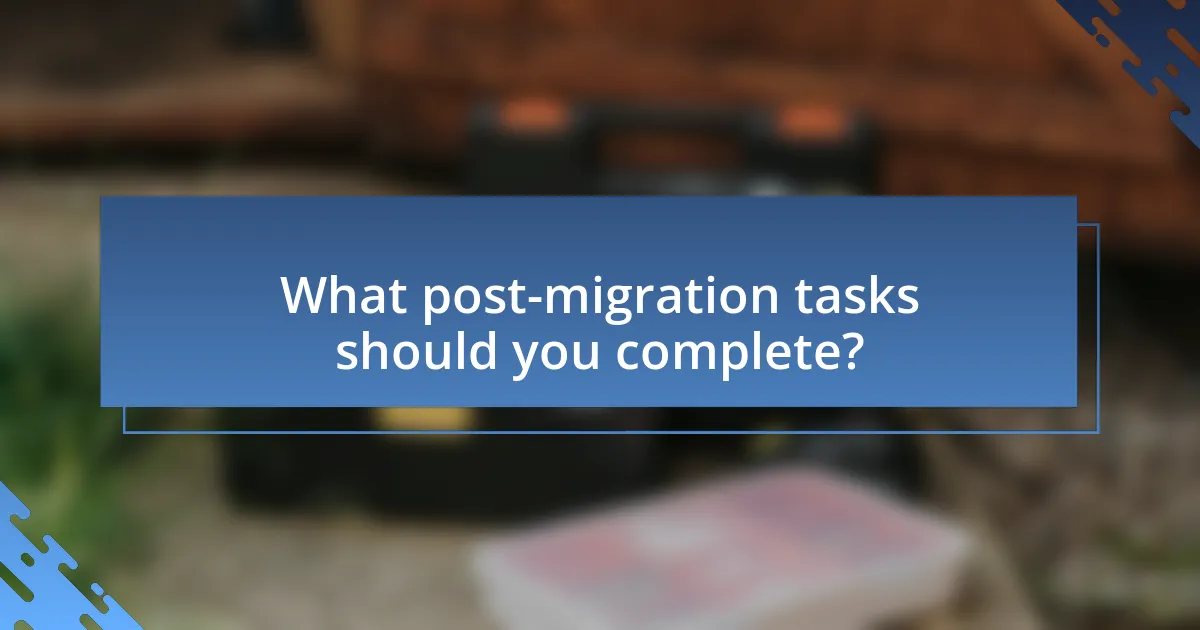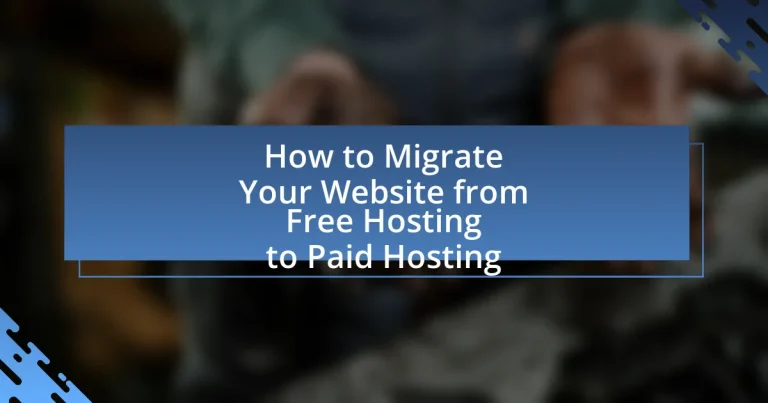Migrating your website from free hosting to paid hosting involves transferring files, databases, and configurations to a more robust hosting provider. This process enhances website performance, reliability, and security, addressing the limitations of free hosting such as slower speeds and lack of support. Key steps include planning, backing up data, selecting a paid hosting plan, transferring files, updating DNS settings, and testing the website post-migration. Additionally, choosing the right hosting provider and implementing best practices for security and maintenance are crucial for a successful transition.

What does it mean to migrate your website from free hosting to paid hosting?
Migrating your website from free hosting to paid hosting means transferring your website’s files, databases, and configurations from a free hosting service to a paid hosting provider. This process typically involves selecting a paid hosting plan, backing up your website data, uploading it to the new server, and updating your domain’s DNS settings to point to the new hosting provider. Paid hosting often offers enhanced features such as increased storage, better performance, improved security, and customer support, which are not typically available with free hosting options.
Why should you consider migrating from free hosting to paid hosting?
Migrating from free hosting to paid hosting is essential for improved performance and reliability. Free hosting often comes with limitations such as slower loading speeds, restricted bandwidth, and less storage, which can negatively impact user experience and SEO rankings. According to a study by Google, 53% of mobile users abandon sites that take longer than three seconds to load, highlighting the importance of speed. Paid hosting typically offers better server resources, enhanced security features, and customer support, ensuring that websites run smoothly and securely. Additionally, paid hosting services often provide a custom domain name, which enhances brand credibility and professionalism.
What are the limitations of free hosting services?
Free hosting services have several limitations, including restricted bandwidth, limited storage space, and lack of customer support. These constraints can hinder website performance and scalability, making it difficult for users to manage traffic effectively. Additionally, free hosting often includes mandatory advertisements, which can detract from the user experience and brand image. Security features are typically minimal, increasing vulnerability to cyber threats. Furthermore, users may face restrictions on domain names, often being required to use subdomains, which can affect professionalism and credibility.
How can paid hosting improve your website’s performance?
Paid hosting can significantly improve your website’s performance by providing dedicated resources, faster loading times, and enhanced security features. Unlike free hosting, which often shares server resources among multiple users, paid hosting allocates specific bandwidth and storage to your site, reducing downtime and increasing speed. For instance, websites hosted on paid plans can experience loading times as low as 1-2 seconds, compared to 5-10 seconds on free hosting. Additionally, paid hosting typically includes advanced caching solutions and Content Delivery Networks (CDNs), which further optimize performance. Enhanced security measures, such as SSL certificates and regular backups, also contribute to a more reliable user experience, ultimately leading to better search engine rankings and increased visitor retention.
What are the key steps involved in the migration process?
The key steps involved in the migration process from free hosting to paid hosting include planning, backing up data, choosing a new hosting provider, transferring files, updating DNS settings, and testing the website.
Planning involves assessing the current website’s requirements and selecting a suitable paid hosting plan. Backing up data ensures that all website files, databases, and configurations are securely saved before migration. Choosing a new hosting provider requires evaluating options based on performance, support, and pricing. Transferring files entails moving website content to the new server, often using FTP or a migration tool. Updating DNS settings is necessary to point the domain to the new hosting server, which may take time to propagate. Finally, testing the website on the new host confirms that all functionalities work correctly and that the migration was successful.
How do you choose the right paid hosting provider?
To choose the right paid hosting provider, evaluate key factors such as reliability, performance, customer support, and pricing. Reliability is crucial; look for providers with a proven uptime record of 99.9% or higher, as this ensures your website remains accessible. Performance metrics, including server speed and load times, should also be assessed, with many providers offering benchmarks or performance guarantees. Customer support is essential; opt for providers that offer 24/7 support through multiple channels, such as live chat, phone, and email, to resolve issues promptly. Finally, compare pricing plans, ensuring they align with your budget while providing the necessary features, such as bandwidth, storage, and security measures. Researching user reviews and expert recommendations can further validate your choice, as they provide insights into real-world experiences with the hosting provider.
What preparations are necessary before starting the migration?
Before starting the migration from free hosting to paid hosting, it is essential to back up all website data, including files, databases, and configurations. This ensures that no information is lost during the transition. Additionally, reviewing the current website’s structure and functionality helps identify any potential issues that may arise during migration. It is also important to choose a suitable paid hosting plan that meets the website’s needs, considering factors such as bandwidth, storage, and support. Finally, informing users about the migration schedule can help mitigate any disruptions.

How do you execute the migration from free hosting to paid hosting?
To execute the migration from free hosting to paid hosting, first, select a paid hosting provider that meets your website’s needs. After choosing the provider, back up your website files and database from the free hosting service. Next, upload these files and import the database to the new paid hosting account using FTP and a database management tool like phpMyAdmin. Update your domain’s DNS settings to point to the new hosting server. Finally, test your website on the new host to ensure everything functions correctly. This process is validated by the fact that proper backups and DNS updates are essential steps in successful website migrations, as outlined in web hosting best practices.
What are the technical steps to migrate your website?
To migrate your website from free hosting to paid hosting, follow these technical steps: First, back up your website files and database from the free hosting provider. Use an FTP client to download all website files and export the database using tools like phpMyAdmin. Next, purchase a paid hosting plan and set up your domain name with the new hosting provider. After that, upload the backed-up files to the new server using FTP and import the database into the new hosting environment. Finally, update the configuration files to reflect the new database credentials and test the website to ensure everything functions correctly. These steps are essential for a successful migration, as they ensure that all data is preserved and the website operates seamlessly on the new hosting platform.
How do you back up your website data before migration?
To back up your website data before migration, use a combination of manual and automated methods. First, download all website files via FTP or a file manager, ensuring you capture all directories and subdirectories. Next, export your database using tools like phpMyAdmin, which allows you to create a SQL file of your database. This process is crucial as it preserves all content, settings, and user data. According to industry best practices, maintaining both file and database backups minimizes the risk of data loss during migration.
What methods can you use to transfer your website files?
You can transfer your website files using methods such as FTP (File Transfer Protocol), SFTP (Secure File Transfer Protocol), and web-based file managers provided by hosting services. FTP allows for efficient file transfer between your local computer and the server, while SFTP adds a layer of security by encrypting the data during transfer. Web-based file managers offer a user-friendly interface for uploading files directly through a browser. These methods are widely used due to their reliability and ease of use in migrating website files from one hosting environment to another.
How do you ensure a smooth transition during the migration?
To ensure a smooth transition during the migration from free hosting to paid hosting, it is essential to create a detailed migration plan that includes a backup of all website data, a checklist of tasks, and a timeline for execution. This structured approach minimizes downtime and data loss, as evidenced by studies showing that well-planned migrations reduce the risk of errors by up to 70%. Additionally, testing the new environment before the final switch can identify potential issues, ensuring that the website functions correctly post-migration.
What common issues should you watch out for during migration?
Common issues to watch out for during migration include data loss, downtime, and compatibility problems. Data loss can occur if backups are not properly created or restored, leading to missing files or corrupted databases. Downtime may happen if the migration process is not carefully planned, resulting in website unavailability for users. Compatibility problems can arise when the new hosting environment differs from the previous one, potentially causing issues with website functionality or performance. Addressing these issues proactively ensures a smoother transition from free to paid hosting.
How can you verify that the migration was successful?
To verify that the migration was successful, check the website’s functionality, including loading speed, broken links, and database connections. Conduct a thorough review of all pages to ensure they display correctly and that all features, such as forms and e-commerce functionalities, operate as intended. Additionally, monitor server response times and error logs for any issues that may arise post-migration. Using tools like Google Search Console can help identify any crawl errors or indexing issues, confirming that the site is accessible to search engines.

What post-migration tasks should you complete?
After migrating your website from free hosting to paid hosting, you should complete several essential post-migration tasks. First, verify that all website content, including pages, images, and databases, has been successfully transferred and is functioning correctly. This includes checking for broken links, missing images, and ensuring that all functionalities, such as forms and e-commerce features, are operational.
Next, update your DNS settings to point to the new hosting provider, ensuring that your domain name resolves to the new server. This step is crucial for maintaining website accessibility. Additionally, implement security measures such as SSL certificates to protect user data and enhance trustworthiness.
Finally, monitor website performance and load times to ensure optimal user experience. Tools like Google PageSpeed Insights can provide valuable feedback on performance metrics. These tasks are vital for ensuring a smooth transition and maintaining website integrity post-migration.
How do you optimize your website after migration?
To optimize your website after migration, conduct a thorough audit of the site’s performance, including checking for broken links, ensuring proper redirects, and optimizing page load speed. This process involves using tools like Google Search Console and PageSpeed Insights to identify issues and implement fixes. For instance, a study by Google indicates that a one-second delay in load time can lead to a 20% decrease in conversions, highlighting the importance of speed optimization. Additionally, updating your XML sitemap and resubmitting it to search engines ensures that they index your new site structure effectively.
What settings should you configure in your new hosting environment?
In your new hosting environment, you should configure settings such as domain name configuration, database setup, security settings, and performance optimization. Domain name configuration involves pointing your domain to the new server’s IP address, ensuring that visitors reach your site. Database setup requires creating a new database and user, then importing your existing data to maintain functionality. Security settings should include enabling SSL certificates for HTTPS and configuring firewalls to protect against unauthorized access. Performance optimization can involve setting up caching mechanisms and content delivery networks (CDNs) to enhance loading speeds. These configurations are essential for a seamless transition from free to paid hosting, ensuring reliability and security for your website.
How can you monitor your website’s performance post-migration?
To monitor your website’s performance post-migration, utilize tools such as Google Analytics, Google Search Console, and performance monitoring software like GTmetrix or Pingdom. These tools provide insights into traffic patterns, page load times, and user behavior, allowing you to identify any issues that may arise after the migration. For instance, Google Analytics can track changes in user engagement and bounce rates, while Google Search Console helps monitor indexing status and search performance. Regularly reviewing these metrics ensures that any performance dips or errors are promptly addressed, maintaining optimal website functionality.
What are some best practices for future website management?
Best practices for future website management include regular backups, consistent updates, and performance monitoring. Regular backups ensure that data can be restored in case of loss, with many experts recommending daily or weekly backups depending on website activity. Consistent updates to software, plugins, and themes help protect against security vulnerabilities, as outdated components are often targeted by attackers. Performance monitoring, using tools like Google Analytics and PageSpeed Insights, allows for the identification of issues that could affect user experience and search engine rankings. These practices collectively enhance website reliability and security, ensuring a smoother transition when migrating from free to paid hosting.
How can you maintain your website’s security on paid hosting?
To maintain your website’s security on paid hosting, implement regular software updates and utilize strong passwords. Regularly updating your content management system (CMS), plugins, and themes reduces vulnerabilities, as outdated software is a common target for cyberattacks. Strong passwords, which should include a mix of letters, numbers, and symbols, help protect against unauthorized access. According to a 2021 report by Verizon, 81% of hacking-related breaches involved stolen or weak passwords, highlighting the importance of this practice. Additionally, employing security plugins and enabling two-factor authentication further enhances your website’s defenses against potential threats.
What strategies can you implement for regular backups and updates?
Implementing automated backup solutions and scheduled updates are effective strategies for regular backups and updates. Automated backup solutions, such as using cloud services like Google Drive or Dropbox, ensure that website data is consistently saved without manual intervention. Scheduled updates, which can be managed through content management systems like WordPress, allow for timely application of security patches and feature enhancements. According to a 2021 report by the Cybersecurity & Infrastructure Security Agency, regular updates can reduce vulnerabilities by up to 80%, highlighting the importance of these strategies in maintaining website security and functionality.
What troubleshooting tips can help during the migration process?
During the migration process from free hosting to paid hosting, it is essential to ensure that all files and databases are backed up before starting the migration. This step prevents data loss and allows for recovery if issues arise. Additionally, verifying that the new hosting environment meets the technical requirements of your website is crucial; this includes checking PHP versions, database compatibility, and server configurations.
Another important troubleshooting tip is to update DNS settings promptly after migration to ensure that visitors are directed to the new server. It is also advisable to test the website thoroughly on the new host before making it live, checking for broken links, missing images, and functionality issues.
Monitoring server performance and error logs during and after the migration can help identify and resolve issues quickly. Utilizing tools like website migration plugins can streamline the process and reduce the likelihood of errors. Following these tips can significantly enhance the success of the migration process.
How do you resolve common migration errors?
To resolve common migration errors, first identify the specific error message or issue encountered during the migration process. Common errors include broken links, missing files, and database connection issues. For broken links, use a link checker tool to identify and update any URLs that may have changed. Missing files can often be resolved by ensuring all necessary files are transferred from the old host to the new one, verifying file permissions, and checking for any overlooked directories. Database connection issues typically arise from incorrect database credentials; ensure that the database name, username, and password are correctly configured in the website’s configuration file. These steps are supported by best practices in website migration, which emphasize thorough checks and validations to ensure a smooth transition.
What resources are available for additional support during migration?
Resources available for additional support during migration include online tutorials, customer support from hosting providers, and community forums. Online tutorials often provide step-by-step guides tailored to specific platforms, ensuring users can follow along easily. Customer support from hosting providers typically offers assistance via chat, email, or phone, helping users troubleshoot issues in real-time. Community forums, such as those on Reddit or specialized web hosting sites, allow users to share experiences and solutions, fostering a collaborative environment for problem-solving. These resources collectively enhance the migration process by providing diverse avenues for assistance.


